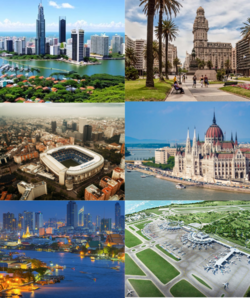San Pera
San Pera | |
|---|---|
Capital City | |
 Clockwise from top left: Downtown San Pera during day; San Pera Gardens in the district of Molen, Estádio Capybaraí in downtown San Pera of the district of Perlores, Bentheses Congressional Hall; Downtown San Pera at Night; San Pera International Airport (SPA) | |
| Nickname: Mango City | |
| Country | Bentho |
| State | District of San Pera |
| Founded | May 1st, 350 B.C.E |
| Founded by | Sílvio Campos Kanashiro |
| Government | |
| • Mayor | Silvana Valdez (BLL) |
| • Vice-Mayor | Emanuel Leal dos Reis |
| Area | |
| • Urban | 250 km2 (96.5 sq mi) |
| • Metro | 800 km2 (309 sq mi) |
| Population (2018) | |
| • Capital City | 1,247,103 (1st) |
| San Pera- Záraco Metropolitan Area (1,893,098) | |
| Website | cityofsanpera.bn |
San Pera is the capital and largest city of Bentho. With a population of roughly 1.5 Million within its cities limit San Pera is situated on the northern coast of the country, on the south bank of the Sea of Vulkaria, most of the embassies that are in Bentho are located inside of the city. About 2 million people live in the greater San Pera metropolitan area, which represents approximately 18% of the country's population.
San Pera was reported to be
Etymology
San Pera orignated from the Sait Pera, a saint from the Sarkosian mytholgy. Saint Pera who lived in mordern day San Pera. Saint Pera helped build San Pera but got pushed off a scafolding by an unkown man. They named it after all of his help.
History
16th Century
17th Century
On 1605, a remarkable shift occurred in the demographics of San Pera, as its population experienced a significant spike. In the span of just one year, the city's inhabitants surged from approximately 10,000 to 15,000 individuals. This rapid growth can be attributed to various factors that contributed to San Pera's appeal as a thriving hub of opportunities and cultural exchange.
The year 1650 marked a major turning point in San Pera's demographic landscape. The city experienced an extraordinary surge in population, reaching a staggering figure of 150,000 residents. This remarkable influx of people came not only from native Bentheese origins but also attracted a diverse range of individuals from other regions, including a notable influx of Vulkarians and immigrants from various countries. San Pera's reputation as a bustling and prosperous city, with its burgeoning economy and vibrant cultural scene, drew people from near and far, seeking better prospects and a chance to be part of its growing success.
By the late 1680s, San Pera had become a melting pot of cultures and nationalities. The population composition reflected the rich tapestry of diversity that had taken root in the city. At this time, approximately 54% of the population identified as Benthese, representing the indigenous people who had inhabited the land for generations. The remaining 26% consisted of individuals of unknown or mixed backgrounds, further highlighting the cosmopolitan nature of San Pera. This blend of cultures, traditions, and identities contributed to the city's vibrant social fabric, fostering an environment of cultural exchange and harmonious coexistence.
The rapid growth in population not only transformed the demographics of San Pera but also had a profound impact on the city's development. As the population swelled, the city expanded to accommodate the growing needs of its residents. New neighborhoods, businesses, and public infrastructure projects emerged, shaping the urban landscape of San Pera. The city thrived as a center of trade, commerce, and intellectual pursuits, attracting talented individuals from diverse backgrounds who contributed to its cultural richness and economic prosperity.
19th Century
In 1822, the construction of the first steam-powered railway connecting San Pera to nearby regions sparked a transportation revolution. This efficient mode of travel not only facilitated the movement of goods but also attracted an influx of visitors eager to explore the city's rich cultural heritage and natural wonders. As tourism began to flourish, entrepreneurs seized the opportunity, establishing hotels, restaurants, and entertainment venues to cater to the growing number of visitors.
The year 1848 witnessed a landmark event in San Pera's history with the establishment of the Bentho Trade Fair. This annual event brought together merchants, traders, and entrepreneurs from across the globe, fostering economic growth and cultural exchange. The fair became a renowned platform for showcasing the city's vibrant industries, such as textiles, manufacturing, and handicrafts. It also served as a catalyst for the exchange of ideas and innovations, further solidifying San Pera's position as a hub of commerce and intellectual pursuits.
As the 19th century progressed, San Pera's skyline transformed with the construction of iconic landmarks. In 1872, the city proudly unveiled the San Pera Grand Theater, an architectural marvel renowned for its opulent interiors and world-class performances. The theater became a cultural epicenter, attracting renowned artists, musicians, and actors from around the world. Its opening marked a golden age of artistic expression and entertainment in the city.
Geography
Demographics
Culture
Education
Transportation
Transportation in San Pera is afordable and due to San Pera being ranked one of the most walkble cities in the world. Owning a car in San Pera is almost pointless. The Trilhas de São Pera is the largest train line in the city with making an income of around 500 million year.
Media
International Relations
Twin Towns - Sister Cities
• The sister city of San Pera is Monsvallis •